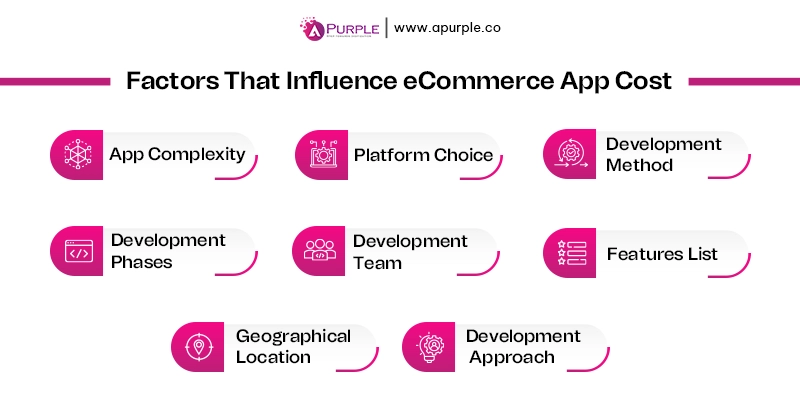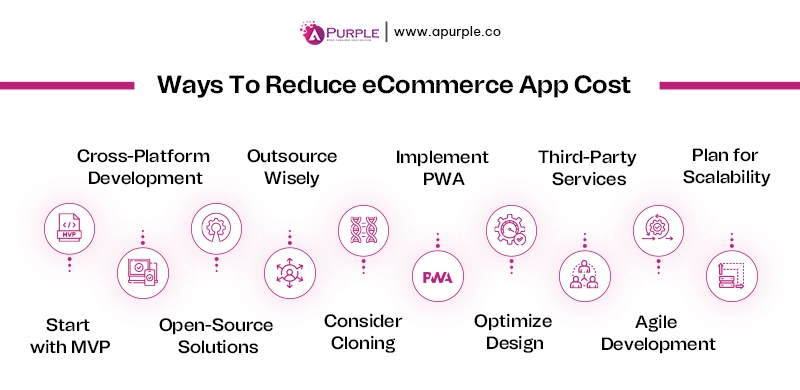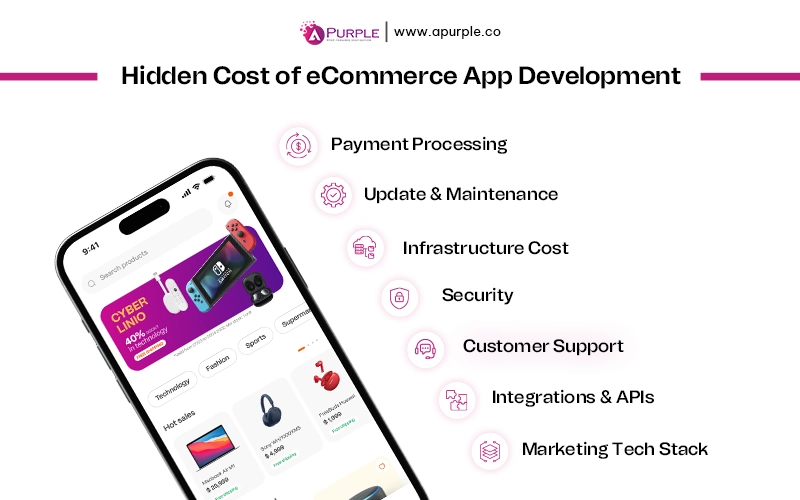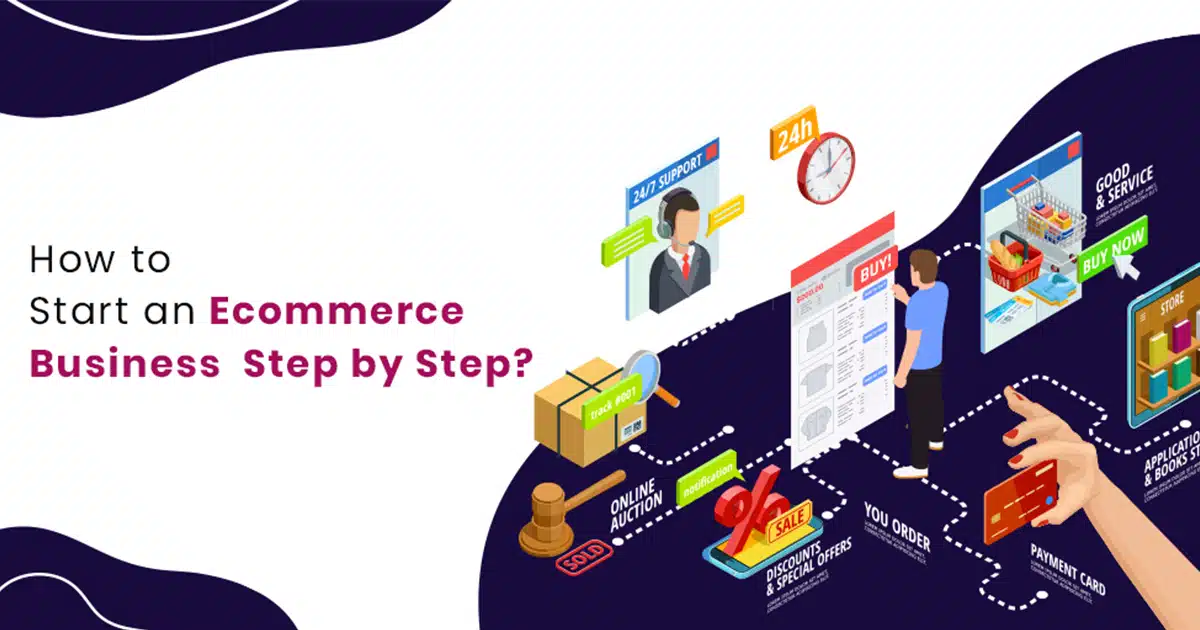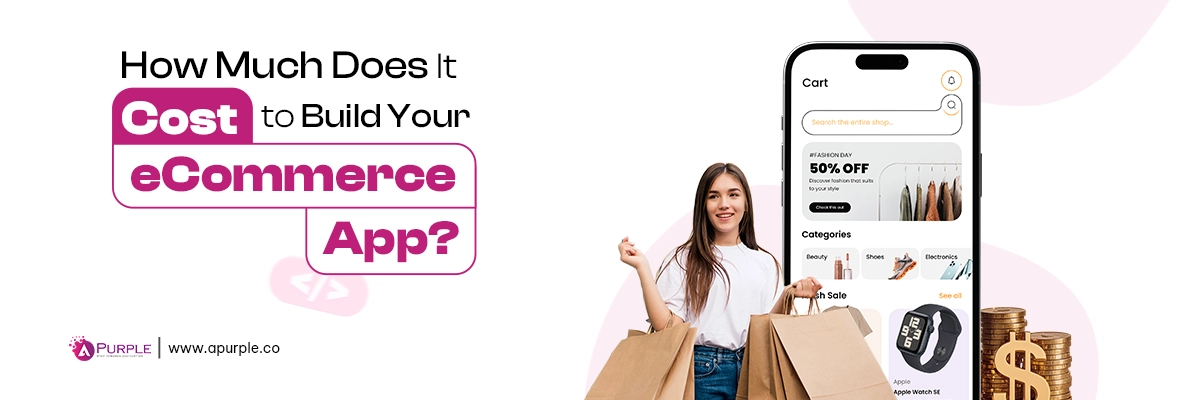
Key Highlights:
- The typical eCommerce app development cost is USD 20,000 to USD 500,000.
- Platform selection, development approach, and feature complexity are primary factors affecting eCommerce app development costs.
- Developer location also significantly impacts pricing, with rates varying from USD 20 to USD 250 per hour across different global regions.
- Critical hidden expenses include ongoing maintenance, payment gateway fees, security compliance, and infrastructure scaling costs.
The mobile commerce revolution has modified purchasers’ purchasing conduct, making an eCommerce app crucial to your startup’s survival and growth. However, knowing the development fees before investing in an eCommerce app can differentiate achievement from failure.
Without a clear budget, here are the common startup mistakes that can happen:
- Running out of funds mid-development like Brandless, which closed operations in 2020 after burning through USD 240 million in venture capital due to unsustainable cost structures. (Source: TechCrunch)
- Launching without critical features like Fast, which shut down in 2022 after raising USD 120 million but couldn’t deliver a competitive one-click payment solution. (Source: Business Insider)
To solve this issue, we have created this cost calculation breakdown to help you effectively plan your eCommerce app development cost and avoid these costly pitfalls.
Let’s get things moving.!
How Much Does eCommerce Application Development Cost?
The true cost of eCommerce app development ranges between USD 20,000 and USD 500,000, depending on the scope of your product and enterprise requirements.
How did we arrive at these numbers? Many calculations and analyses have been performed to determine the approximate cost of developing an eCommerce app. Based on our 10+ years of helping diverse startups set up their eCommerce storefronts, we’ve experienced first-hand how multiple elements influence the eCommerce app cost.
So, as a startup founder, it is imperative to recognize these elements. They will help you optimize eCommerce app development fees while ensuring you do not miss essential capabilities. These factors include the complexity of your app, design requirements, preference of platform, list of functions, integration necessities, customization wishes, and more.
You’ll be able to explore those factors in detail in the next section.
Factors That Influence eCommerce Mobile App Development Cost
Crafting a successful eCommerce storefront requires meticulous planning and precise budgeting. The cost to develop an eCommerce store can vary dramatically based on numerous elements, from simple storefronts to complex marketplaces.
Understanding these variables facilitates you in making informed selections while making plans for your virtual retail store. Let’s discover the critical factors affecting the eCommerce application development cost with practical insights to help you budget effectively for your challenge.
1. The Complexity of The App
The complexity level of your eCommerce app significantly impacts development costs:
- Basic apps offer essential features like product listings and simple checkout processes.
- Mid-level apps include additional functionality such as user profiles and payment gateways.
- Advanced apps incorporate sophisticated features like AI-driven recommendations and AR product visualization.
| Complexity Level | Features | Cost Range (USD) | Development Time | Examples |
|---|---|---|---|---|
| Basic | Simple product catalog, basic search, standard checkout, minimal payment options, simple admin panel | 20,000 – 40,000 | 2-3 months | Small boutique stores, single-vendor shops |
| Mid-Level | User accounts, wishlist, multiple payment gateways, basic analytics, push notifications, order tracking, simple CMS | 40,000 – 80,000 | 3-5 months | Brand-specific retail apps, multi-category stores |
| Advanced | AI recommendations, AR try-on features, advanced search, loyalty programs, multi-language support, complex admin dashboard, advanced analytics | 80,000 – 300,000 | 5-10 months | Marketplace platforms, multivendor solutions |
Note: Pricing Subject to Scope & Final Assessment
2. Choice of Platform
Platform selection directly affects development costs and potential market reach.
- iOS apps generally require less testing due to fewer device variations but reach a smaller, often higher-spending audience.
- Android apps may involve more testing across device types but offer broader market penetration.
- Developing for both platforms simultaneously maximizes reach but increases initial investment.
| Platform | Pros | Cons | Cost Range (USD) |
|---|---|---|---|
| iOS | Higher average revenue per user, faster development, more uniform design standards | Limited market share, premium positioning | 20,000 – 80,000 |
| Android | Larger market share, greater device diversity, wider demographic reach | More testing required, fragmentation issues | 20,000 – 100,000 |
| Both | Maximum market reach, comprehensive customer base, unified brand presence | Higher initial investment, parallel development challenges | 40,000 – 180,000 |
Note: Pricing Subject to Scope & Final Assessment
3. App Development Methodology
Your app development method appreciably influences the app’s overall performance, consumer experience, and final price.
- Opting for Native app development means building separate apps for each platform using platform-specific languages, delivering top performance but at a higher cost.
- Hybrid application development may involve more testing across device types but offer broader market penetration.
- Cross-platform frameworks like React Native or Flutter offer a middle ground with proper performance and reduced development time.
| Development Approach | Tech Stack | Performance | Cost Range (USD) | Best For |
|---|---|---|---|---|
| Native | Swift/Objective-C (iOS), Kotlin/Java (Android) | Superior performance, platform-specific features, best user experience | 40,000 – 200,000 | Performance-critical apps, premium brand experiences |
| Hybrid | Ionic, Cordova, HTML5 | Moderate performance, cost-effective, single codebase | 30,000 – 120,000 | Budget-conscious projects, content-focused apps |
| Cross-Platform | React Native, Flutter, Xamarin | Good performance, faster deployment, near-native experience | 35,000 – 150,000 | Balanced projects needing good performance at a reasonable cost |
Note: Pricing Subject to Scope & Final Assessment
4. Development Phases
The eCommerce app development process comprises several essential phases, each contributing to the overall cost.
- While essential, in-depth planning and research can raise initial costs by ensuring precise requirements and market fit.
- The design phase can add significant expenses, especially with custom interfaces and complex user experiences.
- Development costs escalate with the complexity of features, integrations, and technology choices.
- Comprehensive testing, while vital for quality, increases both time and budget.
- Deployment costs include launch expenses and hosting, while ongoing maintenance adds to long-term costs through updates and performance optimization.
| Development Phase | Activities | Cost Range (USD) | Timeline | Deliverables |
|---|---|---|---|---|
| Discovery & Planning | Market research, competitor analysis, requirement gathering, user personas, feature prioritization, project roadmap | 5,000 – 15,000 | 2-4 weeks | Project specification, wireframes, development plan |
| Design | UX/UI design, wireframing, prototyping, user flow mapping, branding integration, design system creation | 10,000 – 50,000 | 3-8 weeks | UI mockups, interactive prototypes, design assets |
| Development | Frontend and backend coding, API integration, database setup, payment gateway integration, admin panel development | 20,000 – 200,000 | 2-6 months | Functional applications, backend systems, APIs |
| Testing | Quality assurance, functional testing, performance testing, security testing, user acceptance testing, bug fixing | 5,000 – 30,000 | 2-6 weeks | Test reports, certified applications, performance metrics |
| Deployment & Maintenance | App store submission, server setup, monitoring implementation, regular updates, customer support, performance optimization | 10,000 – 100,000 annually | Ongoing | Live application, update schedule, support system |
Note: Pricing Subject to Scope & Final Assessment
5. Development Team
The composition and region of your development team notably affect costs. A comprehensive team comprises project managers, designers, developers, QA professionals, and DevOps engineers. Each role contributes expertise essential for successful app development, and the team size scales with project complexity.
| Team Size | Composition | Project Complexity | Cost Range (USD) |
|---|---|---|---|
| Small (3-5) | Project Manager, Designer, 1-2 Developers, QA Engineer | Basic to Mid-level | 25,000 – 80,000 |
| Medium (6-10) | Project Manager, UX Designer, UI Designer, 3-5 Developers, QA Team, DevOps Engineer | Mid to Advanced | 80,000 – 200,000 |
| Large (10+) | Project Manager, Business Analyst, UI/UX Team, Frontend/Backend Developers, QA Team, DevOps Team, Security Specialist | Advanced | 200,000 – 500,000 |
Note: Pricing Subject to Scope & Final Assessment
6. List of Features
The feature set of your eCommerce app directly influences development costs and complexity.
- Essential features like product catalogs and payment processing keep costs minimal.
- Standard features such as user profiles and order tracking add moderate expenses.
- Advanced capabilities, such as AI-powered personalization and AR buying, appreciably increase fees due to the more substantial development effort and complexity.
Striking the right balance ensures cost-effective development while enhancing user experience.
| Feature Category | Examples | Cost Range (USD) | Development Time |
|---|---|---|---|
| Essential Features | Product catalog, category navigation, cart functionality, checkout process, basic search, payment gateway integration | 20,000 – 50,000+ | 1-3 months |
| Standard Features | User profiles, wishlist, reviews/ratings, multiple payment methods, order tracking, push notifications, basic analytics, simple CMS | 30,000 – 100,000+ | 2-4 months |
| Advanced Features | AR product visualization, AI recommendations, voice search, chatbots, social shopping, loyalty programs, advanced analytics, multi-language support, omnichannel integration | 50,000 – 200,000+ | 3-6 months |
Note: Pricing Subject to Scope & Final Assessment
7. Geographical Region
Developer rates vary significantly by geographical location, affecting the total project cost. North American and Western European developers command premium rates but often deliver high-quality work. Eastern European teams offer a good balance of quality and price, while the app development cost in Saudi Arabia and Asia is the most affordable.
| Region | Hourly Rate (USD) | Project Rate (USD) |
|---|---|---|
| North America | 100 – 250 | 80,000 – 500,000 |
| Western Europe | 80 – 200 | 60,000 – 400,000 |
| Eastern Europe | 40 – 100 | 30,000 – 200,000 |
| Middle East | 40 – 120 | 30,000 – 250,000 |
| Asia | 20 – 70 | 20,000 – 140,000 |
| Australia/New Zealand | 80 – 180 | 60,000 – 350,000 |
8. Development Approach
The development approach considerably influences the price. In-house development provides maximum control and alignment with the business enterprise vision. However, it calls for vast investment in recruitment and infrastructure. Outsourcing offers cost benefits and specialized expertise but may also involve communication barriers and reduced control over the project.
| Development Approach | Control Level | Cost Range (USD) | Best For | Pros | Cons |
|---|---|---|---|---|---|
| In-House | High | 150,000 – 500,000 annually | Long-term strategic projects, core business applications, continuous development | Better alignment with company vision, direct communication, knowledge retention, easier pivoting | Higher costs, recruitment challenges, overhead expenses, longer team setup time |
| Outsource | Medium | 50,000 – 350,000 per project | Standalone projects, specialized needs, limited budgets | Cost-effective, specialized expertise, faster startup, scalable resources | Communication challenges, potential quality control issues, less business context |
| Freelancers | Low | 30,000 – 200,000 per project | Simple projects, limited scope, tight budgets | Lowest cost option, flexible engagement, specialized skills | Highest management overhead, reliability concerns, coordination challenges |
Note: Pricing Subject to Scope & Final Assessment
Pro Tip:
When planning to start an eCommerce business, consider these tips for smart budgeting:
- If you have a reasonable budget, opt for MVP development services for your storefront. This will keep your initial investment minimal and avoid breaking the bank.
- Roll out improvements in phases. This spreads costs over time and lets you make changes based on what customers want.
- Set aside 15-20% of your annual development budget for maintenance.
- Marketing matters as much as your website. To attract customers, plan to spend at least as much on marketing as you do on development.
- Always have backup money. Add 15-25% extra to your budget for unexpected problems or changes.
- Consider all costs – not just the obvious ones. Remember server costs, subscription services, and platform fees.
- Choose features that create value for customers and bring in money, not just what’s easy to build.
eCommerce App Development Cost Estimation Based On Popular eCommerce Apps
Analyzing successful eCommerce applications provides valuable cost benchmarks for your project. Major platforms like Amazon and Shopify represent significant investments, while mid-tier platforms like Etsy demonstrate more moderate development costs. Understanding these benchmarks helps set realistic budget expectations for your eCommerce venture.
| App Example | Type | Estimated Cost (USD) | Key Features | Development Time |
|---|---|---|---|---|
| Amazon | Full-service marketplace | 300,000 – 500,000 | Massive catalog, advanced recommendations, multiple sellers, complex logistics, comprehensive analytics | 10-14 months |
| Shopify | eCommerce platform | 150,000 – 300,000 | Store management, inventory control, payment processing, analytics, marketing tools | 6-10 months |
| Etsy | Specialized marketplace | 100,000 – 250,000 | Artisan focus, custom categories, seller tools, community features | 5-9 months |
| ASOS | Fashion retail | 120,000 – 280,000 | Visual search, outfit recommendations, style guides, size assistant | 6-9 months |
| Zara | Retail brand app | 80,000 – 200,000 | Brand-focused UI, AR try-on, store integration, scan-to-shop | 4-8 months |
| Wayfair | Home goods marketplace | 150,000 – 300,000 | AR room planner, visual search, complex filtering, delivery tracking | 6-10 months |
| Sephora | Beauty retail | 100,000 – 250,000 | Virtual try-on, personalized recommendations, loyalty program | 5-9 months |
Note: Pricing Subject to Scope & Final Assessment
As you saw in an earlier section, developing an eCommerce app similar to an established brand requires significant investment in the initial phase. However, startups are on a tight budget and cannot afford to invest this much money. That’s where cloning an app can be beneficial.
For example, building an Amazon clone reduces design research and provides access to a successful business model but may limit innovation and competitive advantage.
Here’s how you can reduce the cost of cloning while accessing successful business models:
| Clone Type | Customization Level | Cost Range (USD) | Development Time | Market Positioning |
|---|---|---|---|---|
| Basic Clone | Minimal customization, similar UI/UX, core functionality replication | 20,000 – 60,000 | 2-3 months | Difficult differentiation, price competition |
| Enhanced Clone | Moderate customization, some unique features, branded design | 60,000 – 150,000 | 3-5 months | Partial differentiation, requires a marketing focus |
| Inspired App | Significant customization, unique selling points, innovative features | 150,000 – 350,000 | 5-8 months | Strong differentiation, unique value proposition |
10 Ways to Reduce eCommerce Application Development Cost
Developing eCommerce software may be expensive, mainly for startups with restricted budgets. However, strategic planning and innovative selections can substantially lessen the multivendor eCommerce app development cost.
Here are ten powerful ways to hold your expenses down without compromising quality.
1. Start with MVP
Focus on core features that solve your customers’ primary needs. Launch with essential functionality first and gradually add advanced features based on user feedback. This approach saves initial development costs and reduces the risk of building unwanted features.
Before diving into development, research MVP app development costs to set realistic budget expectations.
Pro Tip: Define clear success metrics for your MVP to determine when to scale up with additional features. Track user engagement to identify which features provide the most value.
2. Choose Cross-Platform Development
Instead of growing separate native apps for iOS and Android, use frameworks like React Native or Flutter. This method reduces development time by preserving a single codebase for multiple machines, lowering your eCommerce app development cost.
Pro Tip: Select a cross-platform framework with a full-size community and documentation to ensure lengthy-term sustainability and get access to pre-built components to reduce development time.
3. Use Open-Source Solutions
Instead of building a new website, you may leverage cutting-edge open-source eCommerce frameworks like WooCommerce, Magento, or OpenCart. These systems provide strong foundations with integrated functions for product control, shopping carts, and payment integrations, which can save you a lot of money.
Pro Tip: Contribute to the open-source community to build relationships with developers who can help solve your technically difficult situations without expensive consulting charges.
4. Outsource Wisely
Consider hiring developers from areas with lower labor charges while maintaining exceptional standards. Outsourcing can reduce prices while providing a professional product if you choose the right partners with relevant industry knowledge.
Pro Tip: Always view portfolios, look at reviews, and carry out small test projects before committing to a full-fledged outsourcing relationship. Establish clear communication channels and milestone deliverables.
5. Consider Cloning Established Platforms
Start by cloning a hit eCommerce platform and customizing it to your wishes. This approach saves time and money on preliminary architecture and layout choices that have already been confirmed successfully within the market, decreasing development complexity
Pro Tip: Include value propositions to distinguish your clone from the established platform. Identify competitor gaps or underserved consumer needs to create a specific marketplace role.
6. Implement Progressive Web Apps (PWAs)
PWAs offer app-like experiences without charging fees for native app improvement. They are cross-device compatible, load rapidly, and don’t require app store approval, making them inexpensive options for traditional apps.
Pro Tip: To enhance consumer experience and engagement, emphasize offline functionality on your PWA. Implement powerful caching strategies to ensure your app stays functional despite poor internet connectivity.
7. Optimize eCommerce App Design
Focus on simple and smooth eCommerce app design that prioritizes consumer experience over flashy visuals. A well-deliberated design reduces development complexity and maintenance costs while enhancing conversion rates and purchaser’s delight.
Pro Tip: Use design systems and reusable element libraries to preserve consistency, lessen design time, and streamline the development system in your eCommerce software.
8. Integrate Third-Party Services
Integrate established third-party offerings instead of constructing payment gateways, shipping calculators, or analytics tools from scratch. These solutions are more dependable and cost-effective than custom development, which can impact app prices in the long run.
Pro Tip: Choose offerings with flexible pricing that can scale with your business boom without creating cost bottlenecks as your eCommerce platform expands.
9. Implement Agile Development
Adopt agile app development methodologies to discover and fix issues early in the development method. This method reduces costly rework and guarantees your project remains on target and within finances by breaking it into achievable iterations, which could manage your development fee.
Pro Tip: Hold regular sprint reviews with all stakeholders to maintain alignment and save scope creep, which can boost development costs.
10. Plan for Scalability from the Start
Design your architecture to accommodate growth without requiring entire rebuilds. This foresight prevents expensive overhauls as your user base expands and enables you to control your development fee by avoiding costly rewrites when your platform needs to scale.
Pro Tip: Invest in automated testing to ensure your platform remains strong as you scale and add new functions to your eCommerce application.
Hidden Cost of eCommerce App Development (and Ways to Reduce Them)
Building an eCommerce app involves more than just the initial development cost. Many startup founders are blindsided by unexpected expenses that emerge throughout the development lifecycle and post-launch.
Here are hidden expenses that no one will tell you about:
1. Payment Processing Complexities
eCommerce payment gateway integration involves far more than basic setup fees. You’ll also face ongoing transaction costs, security compliance, multiple currency support, and regular technical updates to keep payment systems functioning smoothly and complying with evolving security standards.
Pro Tip: Start with the essential payment methods for your target market, then gradually expand as revenue justifies the additional integration costs and complexity.
2. Continuous Updates and Maintenance
Your app isn’t always a one-and-carried-out venture. Operating system updates and safety patches become necessary. Also, the user experience expectations evolve. Regular updates ensure your store remains competitive, secure, and compatible with the trendy technology and market needs.
Pro Tip: Build a relationship with a development team that offers maintenance and support packages rather than paying high hourly rates for emergency fixes when troubles arise.
3. Infrastructure Cost
When your store gains traction, server costs can skyrocket. Many founders have determined how much eCommerce costs escalate when a store succeeds overnight, and infrastructure needs to expand. This includes database optimization, improved bandwidth, and more robust web hosting solutions.
Pro Tip: Choose cloud-based solutions with pay-as-you-grow models to avoid significant infrastructure investments before you need them while preserving performance.
4. Security and Compliance
PCI-DSS compliance, data safety rules, and safety audits add massive fees that are often not noted in initial planning. These expenses grow as your user base expands and the regulations around digital commerce become increasingly stringent.
Pro Tip: Build compliance into your foundation rather than retrofitting it later. Implementing security protocols from the start is significantly cheaper than remedying breaches.
5. Customer Support Infrastructure
As transactions grow, so do customer inquiries. The technology and human resources needed to provide the support can quickly become a substantial expense. These include ticketing structures, knowledge bases, and hiring a customer support workforce.
Pro Tip: Implement AI chatbots for common questions while gradually building your customer service team based on actual demand patterns and pain points.
6. Integrations and APIs
Connecting with inventory systems, shipping providers, and marketing tools often involves recurring fees and occasional compatibility issues that require custom development. These costs compound with each new integration and can create technical debt.
Pro Tip: Prioritize integrations that directly impact revenue and customer satisfaction; defer from nice-to-have integrations until they’re necessary for business growth.
7. Marketing Technology Stack
The tools required to attract and convert customers-analytics, email marketing, retargeting-add significant costs beyond the app. These expenses often start small but grow substantially as you expand marketing efforts.
Pro Tip: Seek startup consulting services specializing in lean marketing tech stacks designed for growth-stage businesses rather than prematurely adopting expensive enterprise solutions.
Summing Up
How much cash do you need to invest in your eCommerce app? Startup owners frequently find this question to be a source of sleepless nights. Knowing the cost breakdown of eCommerce app development will help you decide on that component with clarity.
During our 10+ years in the industry, aPurple – a leading ecommerce app development company has guided numerous eCommerce startups and enterprises. Our expertise has helped startups avoid costly pitfalls while constructing scalable, marketplace-prepared online stores. We stabilize cost performance satisfactorily, ensuring your eCommerce investment yields the most returns.
We recognize the precise challenges of eCommerce founders providing transparent pricing with no hidden costs. Ready to build your eCommerce app without breaking the bank? Contact aPurple today for a free 30-minute consultation, and let us become your trusted tech partner.
FAQs
eCommerce app development costs typically range from USD 15,000 to USD 500,000, depending on complexity, features, and development approach. Basic apps with limited features start at the lower end, while a comprehensive marketplace with custom features reaches the higher end.
Major cost factors include platform choice (iOS, Android, or both), feature complexity, design quality, backend infrastructure, third-party integrations, and developer rates by region. Additional factors include security requirements, payment gateway integrations, admin panel complexity, and whether you choose native or cross-platform development.
eCommerce app development usually takes 3-12 months from concept to launch. Simple apps might be completed in 3-4 months, while complex marketplace platforms can take 6-9 months or longer. The timeline depends on features, complexity, team size, and approval processes.
Developing an app like Noon with extensive marketplace features would cost USD 20,000 – USD 200,000. These features include complex user management, vendor portals, advanced search functionality, and multilingual support, which Noon offers in the Middle Eastern market.
Building basic-level iOS and Android eCommerce apps with simple features typically costs USD 20,000 – USD 50,000. However, if you opt for advanced features, the cost may go upto USD 100,000 – USD 150,000.

